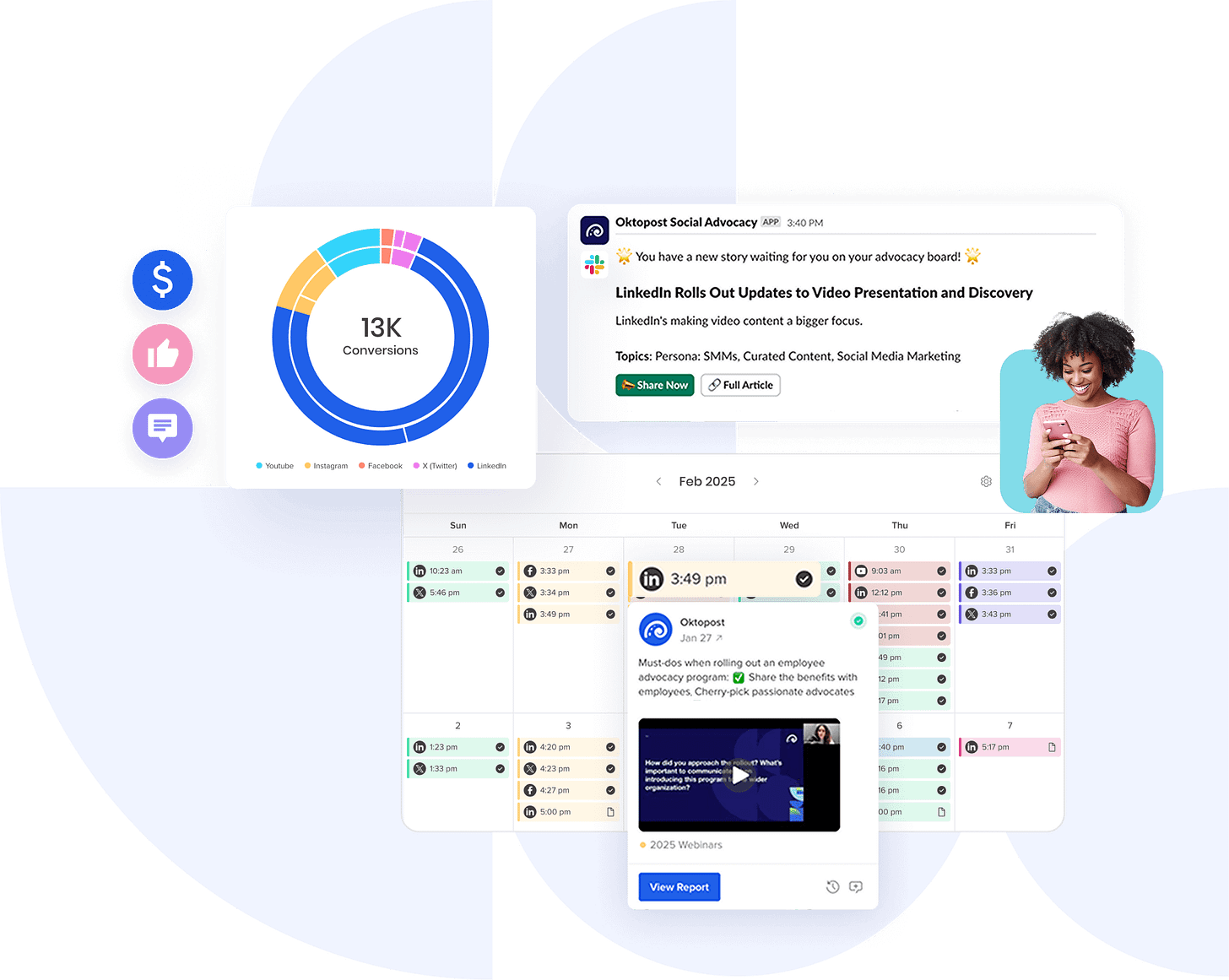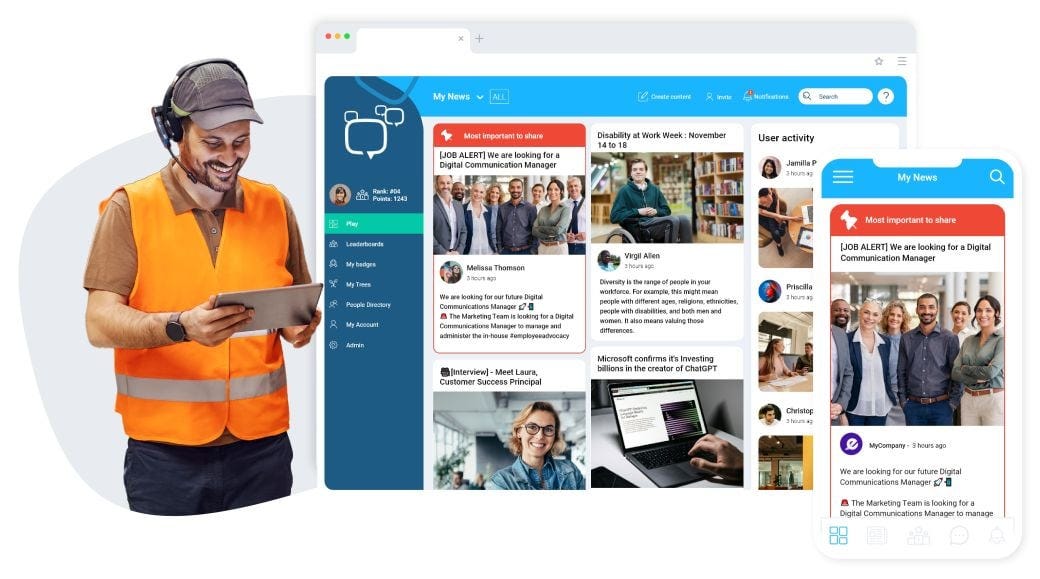Employee Advocacy Tools for ABM & Sales Enablement
You've built your target account list.
Your sales team is reaching out through email & LinkedIn to executives.
BUT…
…they have trouble following up.
How many times can they “retouch” a lead asking them about their decision or pushing them down the funnel?
Strong personal brands lead the way, but for B2B Sales, you need to create a process for employee advocacy. Where your prospects know your sales people as influencers and your company as a thought leader.
I got my tickets for the DO event in Amsterdam on September 11th
Get first-hand insights into what AI and SEO hold for us, marketers, in the near future.Beloved and well-known SEO peers like
Aleyda Solis,
Kevin Indig,
Ross Simmonds,
Lukasz Zelezny,
Viola Eva,
Crystal Carter, and
Talia Wolf
You’ll also hear from experts at companies like Reddit, Google, Microsoft, DHL, and Decathlon, who will enrich your perspective and shed light on essential elements of today’s digital marketing landscape.
🎟️ Use this 50% off code to save your spot: NICKDO50OFF
https://digitalolympus.net/digital-olympus-conference/
P.S.: Don't forget to ping me if you are there, will only be there for a day, let's meet on the break :)
P.S.2: This is not a sponsored post. I will be going to the event, and Alexandra asked me to help her share the word :)
What is Employee Advocacy?
Employee advocacy takes place when employees promote the business they are working from. This (usually) happens either through word of mouth or social media.
Sales Enablement for Account Penetration
While your marketing team and PMMs are creating content, sales rarely engages, interacts, or even knows about it.
Sales enablement material is usually “staying on the shelf”, think of:
Infographics
Data sheets
Reports
Data visualizations
Thought leadership content
Part of the process for ABM alignment is content distribution.
Employee advocacy is part of that process (not the only part). Think of them as a part of the strategic ABM engine.
Instead of just blasting content, you're equipping your most influential people, your sellers and executives, to systematically warm up target accounts, build credibility with key personas, and become the go-to voices in your industry.
This isn't about vanity metrics. It's about using your team's influence to support specific ABM plays and drive revenue.
Here is what you need:
A Curated Content Library
Your sales people (in most cases) are not great writers.
They are great talkers, meeting physically, and creating long-lasting connections with prospects.
What they need from marketing teams is to prepare the material, in an easy and accessible way.
Preparing a library of shareable content, curated, updated, and new content flowing is helping your sales & execs share content online.
That could start as a folder including:
Case studies
Industry reports
Webinar clips / links
Statistics
Anything that would help with the next sales touch.
How to Build Your ABM Advocacy Program
You have the content.
You have the foldering.
What’s missing?
Now the hard part, your sales has to use it. Bear with me to go through the process to enable your sales team, and make them actually follow up the plan.
Step 1: Set ABM-Specific Goals
Define what success looks like in the context of your target accounts. You need to prove this process works, for that, you need your sales & execs to be both active on social and talking with prospects using the content you created.
Set goals:
Each sales person posts 3-5 times per week
Tracking engagement from the top 50 target accounts
Re-starting conversations with key personas e.g. reaching out to 10 key account personas from target accounts (social selling)
Step 2: Get Leadership Buy-In and Participation
If your CEO and VP of Sales aren't actively using LinkedIn to engage with their networks, no one else will take it seriously.
Their activity validates the strategy.
And, senior leadership is more likely to get some eyeballs to your content. They have to be leading the strategy.
Step 3: Launch with a Leaderboard and Gamify It
Salespeople are inherently competitive. Use this to your advantage.
Scoring: Award points for shares, but give bonus points for engagement (likes, comments, reshares) from people at target accounts.
Prizes: Offer rewards that matter. A bigger commission kicker on a socially-influenced deal, a premium tech gadget, or lunch with the CEO.
Giulia de Oliveira Camargo create a gamified dashboard for her team. Read her post on what she did.
Step 4: The Weekly ABM Check-in
Integrate advocacy into your existing sales stand-ups or a weekly Slack message. Create a Slack/Teams group chat and get everyone for 30 minutes each week to share experiences, wins, and stories.
Celebrate Achievements: Publicly congratulate the rep with the most target account engagement, impressions, likes.
Highlight a Key Win: "A post from Sarah this week was re-shared by the CTO at ACME Corp. That's a huge win! Let's all engage with that." This connects activity to tangible progress.
Share New Intel: Remind them of new content, support them in scheduling the posts, and ask what they need to move deals forward.
A Look at the Top Tools for Employee Advocacy
For an ABM-focused strategy, you need a tool that can prove its impact on revenue, not just clicks.
Below are tools where you can support employee advocacy. Preparing content on the platform that sales can choose & pick to schedule, reducing the time required by them.
P.S.: My team has experience with Everyone social, but I tried to compile a more complete list and give you some choices :)
Oktopost
This is the go-to for any serious B2B marketer running ABM. It's designed to track social's influence on the sales pipeline.
Pros: Deep integrations with marketing automation (Marketo, HubSpot, etc.), robust analytics that tie social shares directly to leads and revenue from specific accounts, excellent for managing compliance.
Cons: Can be more complex and expensive, which might be overkill if you can't commit to tracking ROI.
Why It's Great for ABM: You can see exactly which target accounts are engaging with your team's content. It's the best tool for proving that your social selling efforts are actually influencing deals.
Sociabble
If your ABM strategy involves building a strong internal culture around your target accounts, Sociabble is a powerful choice.
Pros: Best-in-class gamification that drives high user adoption, strong internal communication features, supports user-generated content.
Cons: Analytics are more focused on engagement metrics than the hard-and-fast revenue attribution of Oktopost.
Why It's Great for ABM: You can create specific channels and leaderboards for your ABM team, fostering competition and collaboration around engaging key accounts. It excels at rallying the team.
This platform is designed to empower your executives and sales leaders as individual thought leaders.
Pros: Empowers users to discover and share relevant third-party content, fostering authentic influence. The UI is incredibly intuitive and mobile-friendly.
Cons: Less direct marketing control over messaging. The focus is more on the individual's brand than a unified company campaign.
Why It's Great for ABM: It's the best choice for a "trust your experts" strategy. It allows your C-suite and top sales reps to build authentic, credible personal brands that resonate with senior leaders at target companies.
Extra Tip: Win the Hiring War
When your executives build their personal brands to influence target accounts, they also attract top talent. A-players want to work for visible, respected leaders.
Your C-suite's influence in the market becomes a powerful, passive recruiting tool that helps you hire the best people to serve your most important clients.
So, stop thinking of your team's social presence as a liability to be managed. Start seeing it as your most valuable asset for penetrating your target accounts.
How are you currently enabling your sales and leadership teams to build influence within your key accounts?






